九年级下册英语第13单元SectionA-1
- 格式:ppt
- 大小:4.04 MB
- 文档页数:51

九年级英语Unit13Unit 13 We’re trying to save the earth!一、课程标准解读本单元教学内容是九年级英语下册第13单元,主要围绕着有关保护环境这一话题,以“谈论污染和保护环境”为交际功能,让学生认识环境问题及谈论如何保护环境。
根据《义务教育英语课程标准》总目标和五级目标要求,学生在学习本单元后,应该达到以下目标:(一)语言技能目标1.听:能根据语调和重音,理解说话者的意图;能听懂有关环保方面的谈话,并能从中提取信息和观点;能借助构词法克服生词障碍,理解大意;能在听的过程中用适当方式做出反应;能针对所听语段的内容记录简单信息。
2.说:能就关于“环保”的话题提供信息,表达简单的观点和意见,参与讨论;能与他人沟通,合作完成任务;能在口头表达中进行适当的自我修正;能根据关于“环保”的话题进行情景对话;能在以上口语活动中做到语音、语调自然,语气恰当。
3.读:能根据上下文和构词法(前缀、后缀)推断、理解生词含义;能理解段落中各句子之间的逻辑,能够关注文章中的细节。
4.写:能围绕“环保”为话题写一篇表达自己的观点的文章。
(二)、语言知识目标1.词汇:学会使用litter cost harmful afford reusable recycle等词的用法。
2.语法:复习现在进行时,现在完成时,被动语态,情态动词及y 一般过去时(used to)的用法。
3.功能:能准确理解与运用相关语言谈论环保的话题。
4.话题:围绕环保话题恰当理解与运用相关的语言表达形式。
(三)情感态度目标勇于发表自己对环保的观点和意见。
让学生分辨是非,增强他们的环保意识,让学生受到良好的思想教育。
(四)学习策略目标能根据上下文和构词法(前缀、后缀)推断、理解生词含义;能理解段落中各句子之间的逻辑,能够关注文章中的细节。
(五)文化意识目标引导学生关爱动物、保护环境。
二、中考考纲及考题分析2013年中考考纲:现在进行时,现在完成时,被动语态,情态动词及一般过去时(used to)的用法。
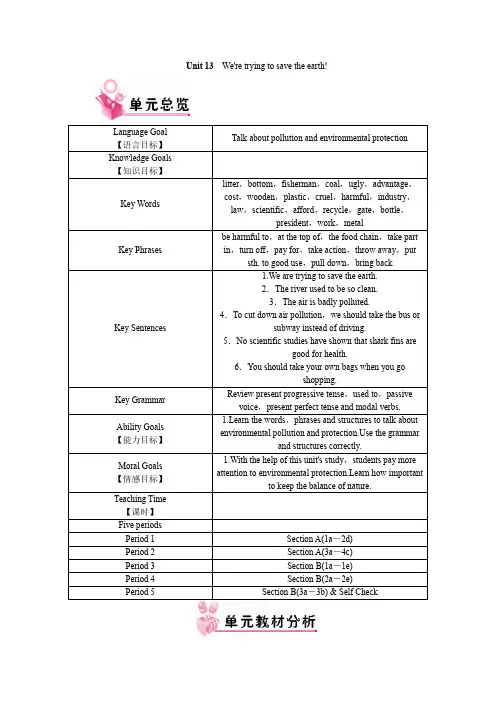
Unit 13We're trying to save the earth!本单元围绕环境保护的话题,并用主题图片表现噪音污染、空气污染、水污染等内容,目的是为了让学生对环境的破坏有一个直观的认识,从而激发学生强烈的社会责任感和对未来发展的思考。
Section A的重点是让学生掌握与环境污染和环境保护相关的词汇和句型,同时引导学生关爱动物、保护环境。
教学难点是让学生学会正确使用连词和结合生活实际讲述如何保护环境。
Section B在Section A所学的基础上,进一步谈论如何保护环境。
教学重点是让学生了解环境保护的方式,并落实到积极的行动当中,同时还有阅读策略和写作技巧的训练。
教学难点是让学生在阅读2a文章之后,根据所给词根找出衍生出的不同词汇,并理解前缀和后缀的不同用法。
The First Period—Section A(1a-2d)Teaching Important Points【教学重点】Key words & phrases:litter,bottom,fisherman,coal,ugly,advantage,cost,wooden,plasticnoise pollution,air pollution,water pollution,be full of,play a part in,turn…into,cut down air pollutionKey sentences:1.Even the bottom of the river was full of rubbish.2.It used to be so clean.3.Everyone in this town should play a part in cleaning it up.4.The air is badly polluted because there are more cars on the road these days.5.The air has become really polluted around here.6.We're trying to save the earth.Key structure:should+do;used to+do;have/has+done;be+done;be+doinge.g.Everyone should help to clean up the river.The air has become really polluted.I used to be able to see stars in the sky.The air is badly polluted.Teaching Difficult Points【教学难点】★Practice the structures to talk about pollution and environmental protection.Teaching Aids【教学工具】A tape recorder,CAI or multimedia courseware.Teaching Steps【教学过程】★Step 1Leading in【新课导入】1.Greeting2.Discussion and reviewDiscuss with the students,like this:T:What kinds of pollution are there these days?S:…T:What causes the pollution?S:…3.Review the words and expressions about the topic.★Step 2Cooperative inquiry【合作探究】1.Finish the task in 1a①Show pictures or play videos about pollution and talk about the pollution.②Read these phrases in 1a.Look at the pictures in 1a and say what they see in the pictures.Write down the words and add more words.③Ask students to say out their words in each kind of pollution.2.Finish the task in 1b①Read the instructions.Get the students to read the contents in the chart and think of what they will fill in the blanks.②Play the recording for the first time.Students listen and fill in the words.③Play the recording a second time.Ask them to check the answers.Then ask the questions.Students answer with full sentences.④Ask more questions to help students learn more details.Then play the recording for the students to role-pay the conversation.3.Finish the task in 1c①Show the key words of the conversation.Ask students to retell the contents in the chart.Like this:What:dirty;bottom,rubbish;fishWhy:littering,putting wasteHow:write to,close down;help to clean up②Read aloud the model dialogue in 1c.Then in pairs,do the oral practice with more words.③Ask two pairs to perform in class.4.Finish the tasks in 2a-2b①Use PPT or pictures to show the four kinds of pollution.Get the groups of students to havea competition to say words about the pollution one by one.land pollution:…air pollution:…noise pollution:…water pollution:…②Get the students to write down these words in their notebooks.③Play the recording for the first time.Students listen and circle the kinds of pollution.Check answers with the class.④Read the sentences in 2b.Predict the contents they will fill in.Play the recording.Students listen and complete the sentences.⑤Play the recording again.Check the answers with the whole class.5.Finish the task in 2c①Read the sample conversation in 2c.Then Read the listening materials and discuss in pairs what causes the two kinds of pollution.②Students work in pairs,making dialogues.③Ask three pairs to role-play their conversations to the class.6.Finish the task in 2d①Talk about the picture in 2d.Ask:What are your ideas for solving the air pollution/waste pollution problem?Present the new words in the conversation.Such as,coal,advantage,wooden,plastic,takeaway,bin,…②Read the conversation in 2d quickly.Find out the problems about environmental pollution in the dialogue.③Read the conversation again.Ask the students to find the ways to solve the problems of air and waste pollution.④Read aloud the conversation by the recording.⑤Learn the useful expressions:What are your ideas for doing…To cut down air pollution,we should…So together,our actions can make a difference and…⑥Role-play or read the conversation in pairs until fluently.★Step 3Homework1.What are your ideas for solving the waste pollution problem?2.Write the words about the four kinds of pollution.3.Translate the following sentences into English.(1)我们正在想办法拯救地球。
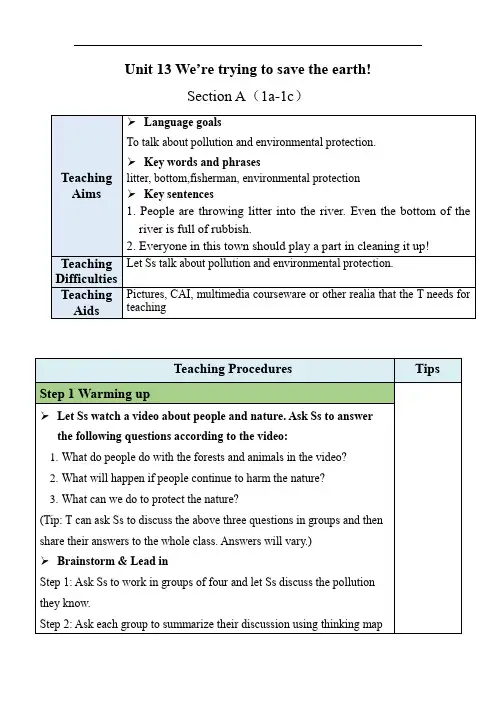
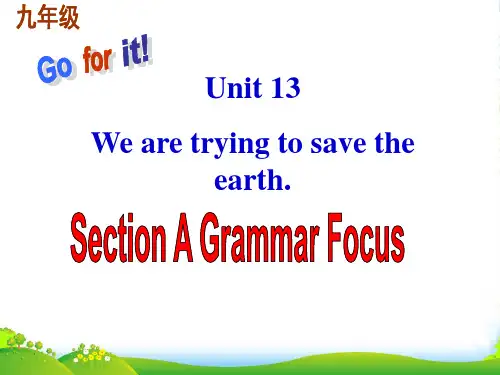
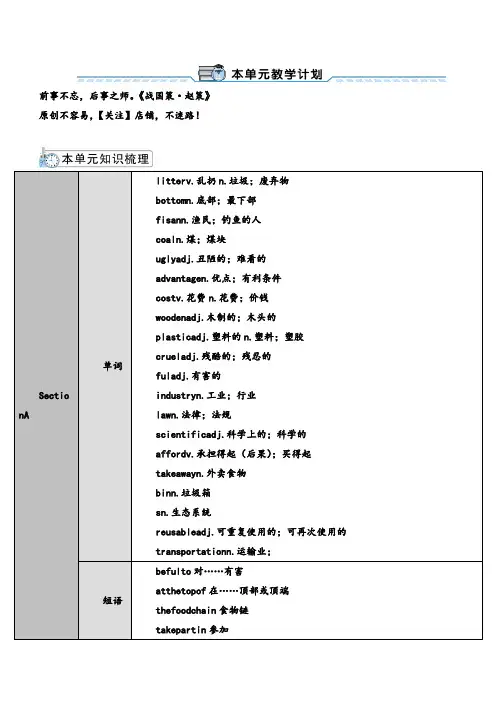
前事不忘,后事之师。
《战国策·赵策》原创不容易,【关注】店铺,不迷路!Sectio nA 单词litterv.乱扔n.垃圾;废弃物bottomn.底部;最下部fisann.渔民;钓鱼的人coaln.煤;煤块uglyadj.丑陋的;难看的advantagen.优点;有利条件costv.花费n.花费;价钱woodenadj.木制的;木头的plasticadj.塑料的n.塑料;塑胶crueladj.残酷的;残忍的fuladj.有害的industryn.工业;行业lawn.法律;法规scientificadj.科学上的;科学的affordv.承担得起(后果);买得起takeawayn.外卖食物binn.垃圾箱sn.生态系统reusableadj.可重复使用的;可再次使用的transportationn.运输业;短语befulto对……有害atthetopof在……顶部或顶端thefoodchain食物链takepartin参加句型1.Doyouofenthrowawaythingsyoudon'tneedanymore?你是否经常把你不再需要的东西扔掉呢?2.efromoldbuildingsaroundallsonline.她开了一家小店卖她制作的包,并且她还开了一家网店出售它们。
语法现在进行时;被动语态;现在完成时知识目标复习现在进行时、现在完成时和被动语态等的用法。
能力目标以“保护环境”为主题,运用本课相关句型与他人展开讨论;能向大家介绍有哪几种污染类型,怎样回收利用废弃物品等。
情感目标体会到保护环境重要性,学会保护大自然、保护地球,从身边的小事做起,号召大家参与到保护环境的行动中来。
【课时建议】本单元建议5课时SectionA(1a~2d)……………………………………………………………………………………1课时SectionA(3a~4c)……………………………………………………………………………………1课时SectionB(1a~1e)…………………………………………………………………………………1课时SectionB(2a~2e)…………………………………………………………………………………1课时SectionB(3a~3b)……………………………………………………………………………………1课时词汇短语:主要采用多媒体及图片展示法。
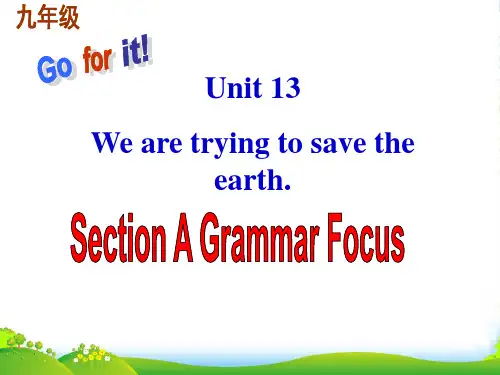
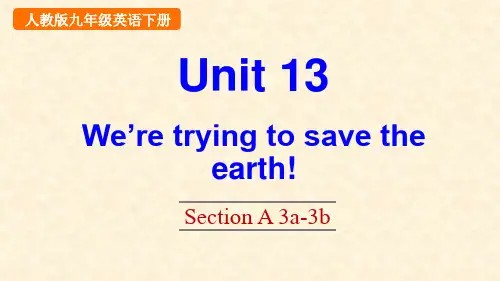
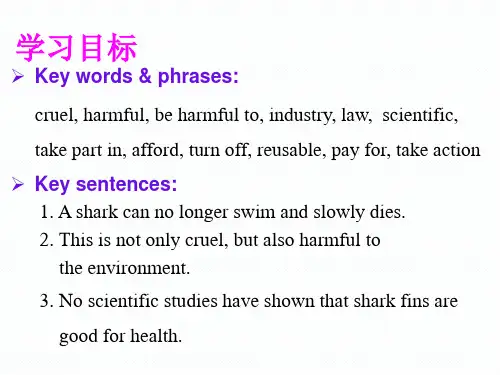
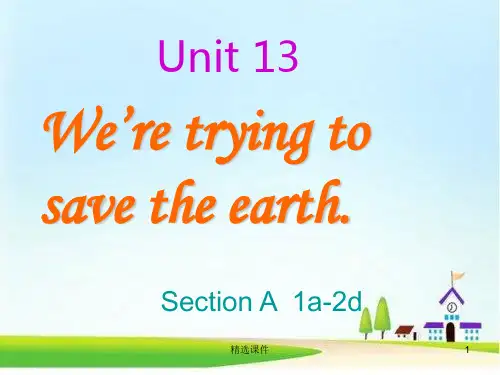
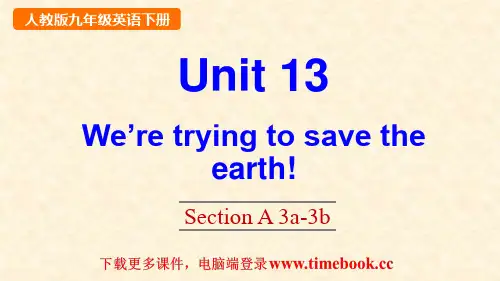
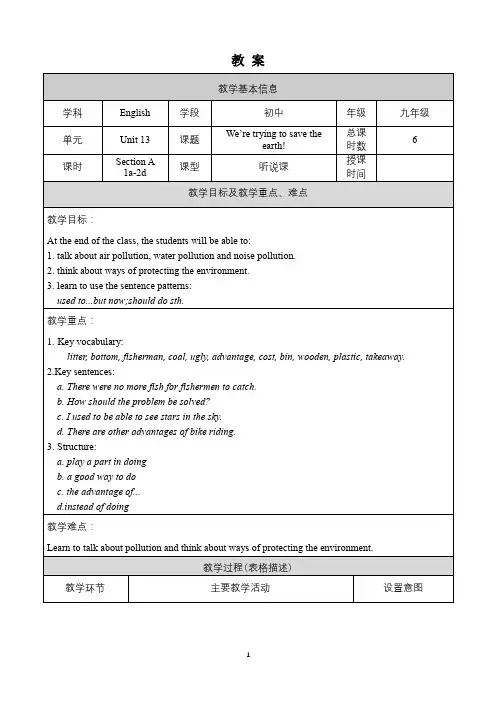
Unit 13We're trying to save the earth! 单元目标知识目标Section A重点单词litter,bottom,fisherman,coal,ugly,advantage,cost,wooden,plastic,takeaway,bin,shark,fin,cruel,harmful,chain,ecosystem,industry,law,scientific,afford,reusable,transportation重点短语be harmful to,at the top of,the food chain,take part in,turn off,pay for,take action重点句子1.We're trying to save the earth!2.Everyone in this town should play a part in cleaning it up!3.Well,to cut down air pollution,we should take the bus orsubway instead o f driving.4.So together,our actions can make a difference and lead toa better future!5.So far,no scientific studies have shown that shark fins aregood for health,so why eat them?Section B重点单词recycle,napkin,gate,bottle,president,inspiration,iron,work,metal,creativity重点短语throw away,put sth.to good use,pull...down,upside down,bring back重点句子1.Do you often throw away things you don't need anymo re?2.She lives in a house in the UK that she built herself out ofrubbish.3.And the gate in front of her house is made of rocks and oldglass bottles.4.He is known for using iron...5.Not only can the art bring happiness to others,but it alsoshows that even cold,hard iron can be brought back to lifewith a little creativity.语法目标复习现在进行时、used to、被动语态、现在完成时和情态动词的用法技能目标谈论问题并找出解决办法写作目标针对环境问题写出自己的见解情感目标增加学生对环境污染问题的关注,鼓励学生养成爱护环境的好习惯第一课时Section A(1a-2d) 课时目标重点单词litter v.乱扔n.垃圾;废弃物bottom n.底部;最下部fisherman n.渔民;钓鱼的人coal n.煤;煤块ugly adj.丑陋的;难看的advantage n.优点;有利条件cost v.花费n.花费;价钱wooden adj.木制的;木头的plastic adj.塑料的n.塑料;塑胶takeaway n.外卖食物bin n.垃圾箱重点句子1.We're trying to save the earth!我们正在尽力拯救地球!2.Everyone in this town should play a part in cleaning it up!这个镇上的每个人都应该参与进来清理它!3.Well,to cut down air pollution,we should take the bus or subway instead of dr iving.嗯,为了减少空气污染,我们应该乘坐公交车或地铁,而不是开车。